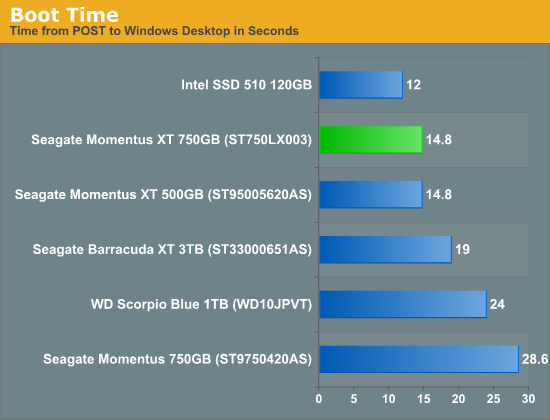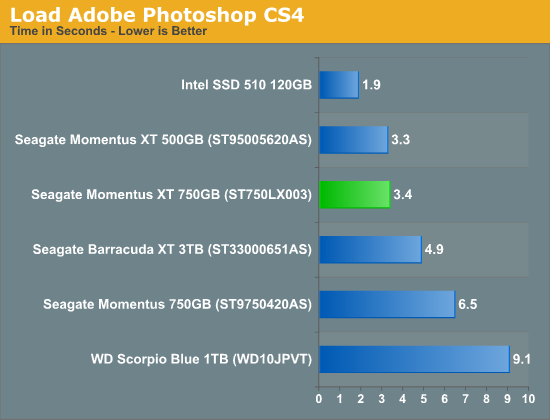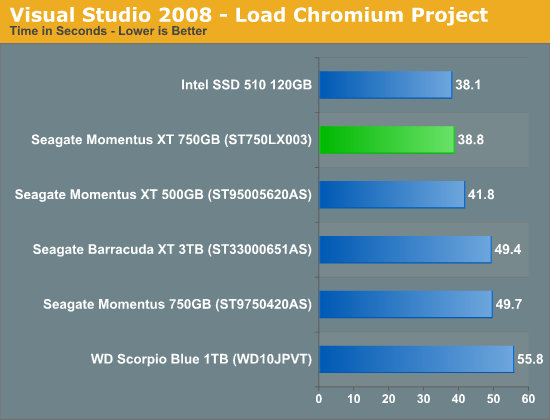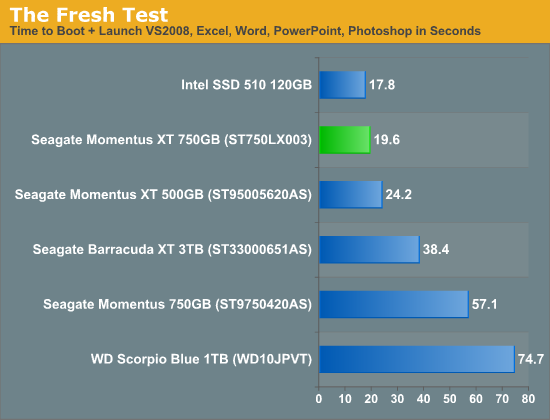Seagate 2nd Generation Momentus XT (750GB) Hybrid HDD Review
by Anand Lal Shimpi on December 13, 2011 12:51 AM EST- Posted in
- Storage
- Seagate
- Momentus XT
- Hybrid Drive
- HDDs
- SSHDs
Once More, With Feeling
Just as we did in our original Momentus XT review, we'll start with a look at some hand-timed application tests.
First up is a good old fashioned boot test. I measured boot time on our testbed from POST to first seeing the mouse cursor on the Windows 7 desktop. This isn't a timing of actual boot-to-use since more loading happens even after you get to the desktop, but it does encapsulate much of the Windows 7 boot process.
All tests were repeated until performance leveled off. In the case of an SSD, this was after just one run. In the case of the 500GB Momentus XT, it took five runs to get there, whereas the second generation model was there after just two. The traditional hard drives each took a few runs for their performance to stabilize as well due to Windows 7's own boot optimizations taking effect.

Boot performance continues to be very impressive on the Momentus XT. It's still not quite as fast as a high end SSD, but it's definitely faster than a traditional hard drive (even a faster, 3.5" model). With a larger NAND cache, your boot time is more likely to remain this low even as other applications and data are pulled into the cache.
Next let's look at a simple application launch test. Adobe Photoshop continues to be one of the more stressful workloads for a hard drive, even down to launching the application. Here I measured from the time I clicked on the Photoshop icon in the Start Menu to first appearance of the blank Photoshop canvas and toolbars. Again, I repeated this test until performance leveled off in all cases.
For the Momentus XT performance fluctuated and it never truly settled on a single launch time. Performance started out at over 5.6 seconds but for all runs after the 2nd launch time ranged in the upper 2s - upper 3s. For its results as well as those from all of the hard drives, I averaged five launch times and presented those averages. The lone SSD in this comparison delivered consistent performance across all runs.

Here the Momentus XT continues to do very well, for a hard drive. It's faster than any of our mechanical drives, and significantly faster than your run-of-the-mill 5400RPM 2.5" drive for sure. A good SSD is still around 70% faster than the Momentus XT.
When constructing our Visual Studio 2008 project build benchmark for our CPU reviews I was reminded just how much of a pain it is to do development work on a system with a hard drive. I tried using the same benchmark to measure drive performance however it seems I used too good of a CPU benchmark as disk performance plays a small role in actual compile time here. Instead I looked at the impact of disk performance on loading the Chromium project in VS2008. I used the same test rules as before, presenting performance once it has leveled off for all drives involved. Once again, the SSD delivered peak performance after a single run. The Momentus XT was able to do it after 2 - 3 runs. Performance didn't improve over multiple runs with the traditional hard drives.

There's a clear division between the NAND equipped Momentus XTs and the traditional hard drives here, but not so much between the former and the Intel SSD 510. I can definitely understand Seagate's temptation to draw the comparison to the performance of an SSD. The problem with doing this is highlighted in my comments above however. While the SSD always performed to the best of its abilities in our tests, regardless of the number of times I ran a test, the Momentus XT needed a couple of runs to get to that point. The NAND cache isn't overly predictive and as a result the first time you do almost anything the Momentus XT will perform like a traditional 7200RPM 2.5" hard drive. Given a light enough workload, the Momentus XT should be able to eventually fit much of the most frequently read data into its cache, but the process of actually getting there can still be painful.
For our last application level benchmark I turn to something I've used since the early days of SSD reviews: the fresh test. Take our boot test from earlier, and string together a series of application launches after you hit the desktop. In this case I'm launching Excel 2007, PowerPoint 2007, Word 2007, Visual Studio 2008 and Photoshop CS4 as soon as the system boots. I measure the time from POST until the last application is completely launched. I call this the fresh test because when you first build a machine everything, even on a traditional hard drive, performs quickly. Load up a lot of applications and use your system for a while and you'll soon notice that things aren't quite as snappy any more. Defragmenting your drive can help but after a certain point it's the bloat of everything installed that really limits performance. A better test would be to use an image that was months (if not years) old, but I've found that this benchmark gets the job done. Lower numbers here translate very well to a snappier system and one that feels new regardless of what you've got loaded on it. SSDs truly excel in the fresh test, but what about the Momentus XT?

Surprisingly enough, the Momentus XT does extremely well. The newer model clearly does a better job of keeping more data in NAND, but both are head and shoulders above the traditional hard drives. If you have a fairly regular usage pattern (E.g. you always run the same 5 or 6 applications), the Momentus XT can significantly improve the overall user experience. In some cases, it can even approach the performance of an SSD.










98 Comments
View All Comments
truthbeacon - Tuesday, December 13, 2011 - link
I am stumped. If you are comparing this Hybrid HDD to HDDs and SSDs, why didn't you throw 'high-performance' drives in the test metric, such as a Scorpio Black or Velociraptor?Anand Lal Shimpi - Tuesday, December 13, 2011 - link
The regular Momentus 750GB is a 7200RPM 2.5-inch drive, that covers the high performance 2.5" drive segment. My VR200M has unfortunately died since the original review, but I threw the 3.5" Barracuda XT as a representative from the 3.5" high performance category.Note that in the areas where the Momentus XT really shines, even the VR200M wouldn't be enough to close the gap.
Take care,
Anand
deputc26 - Tuesday, December 13, 2011 - link
"Drive Power Consumption - Sequential Write"both are identical on page 6
http://www.anandtech.com/show/5160/seagate-2nd-gen...
Anand Lal Shimpi - Tuesday, December 13, 2011 - link
Fixed! Thanks!dagamer34 - Tuesday, December 13, 2011 - link
I feel like the true enthusiasts have poo pooed solutions like this because they've moved to pure SSD-based systems in the 2.5" firm factor and then have huge 2-3TB HDD arrays for media storage. While certainly there will be plenty of hard drives sold with a 2.5" slot, I just get the feeling that because of laptops like the MacBook Air, Intel's ultrabook initiative, and the general crappy pricing of mechanical HDDs right now, this technology is a bit too little, too late and may never really go mainstream. Certainly improvements can be made to get near SSD levels of performance while having a large amount of storage, but the 5-10year future is clearly SSD only, and it must be troubling for Seagate to be aware of that eventual possibility.Jedi2155 - Tuesday, December 13, 2011 - link
I currently have a 256 GB SSD on my main home system, and I'm debating swapping that out for this due to the space limitations on my SSD. All those high end games take up a whopping amount of space as does Steam.It would be better to have an SSD on my work machine or laptop than my home desktop at this rate. This seems like a good downgrade/replacement. I wonder if prices might drop anytime soon to under $200. I don't really feel that its worth $250 although the market is still really bad...
A5 - Tuesday, December 13, 2011 - link
The solution to that is to use an app like Steam Mover to store the games you aren't playing at the moment on your mechanical disks instead of the SSD. No reason to have more than 1-2 games on your SSD at a given time.Jedi2155 - Wednesday, December 14, 2011 - link
I play at random between 3-10 games depending on the situation as my friends are varied which as caused me to just install it all on the main SSD. I have a separate HDD for other games. I will look into Steam Mover as I've been meaning to do something of the sort but Symbolic Linking is too much work for the games I have installed and having to do it for each individual game.Ammaross - Wednesday, December 14, 2011 - link
Get an Z-series Intel chipset and use the drive caching capabilities of it. Then you can have a 60GB MLC (or SLC since you're willing to pay for a 256GB SSD) as a disk cache to some high-performance WD Black 2TB spinner. Basically it's a build-it-yourself Momentus drive.ltcommanderdata - Tuesday, December 13, 2011 - link
As you mentioned, the ideal use-case for hybrid drives is for notebooks where you want to combine better speed with large capacity. However, it should be noted that the Momentus XT is 9.7mm thick, just over the standard 9.5mm of most 2.5" drives, which could makes it's use problematic on notebooks with little space tolerance.On another note, one of Seagate marketing features is FAST Factor Boot, which is supposed to be a dedicated partition on the NAND for caching OS boot files so they can't be evicted by other file activity over time. Would you know how well this dedicated OS cache works for dual boot systems? Can if figure out your primary OS and only cache that, expand the partition to accommodate both OS or do the two OSs thrash each other?